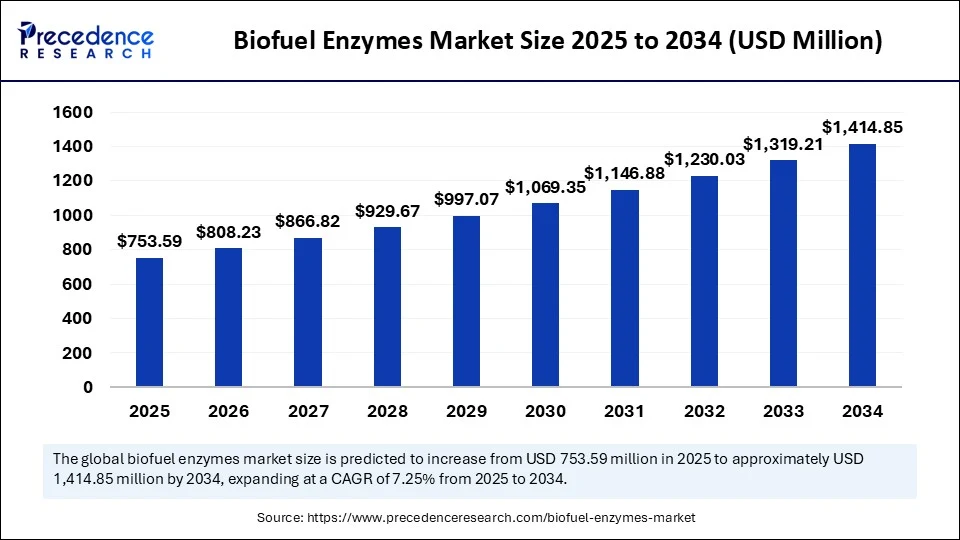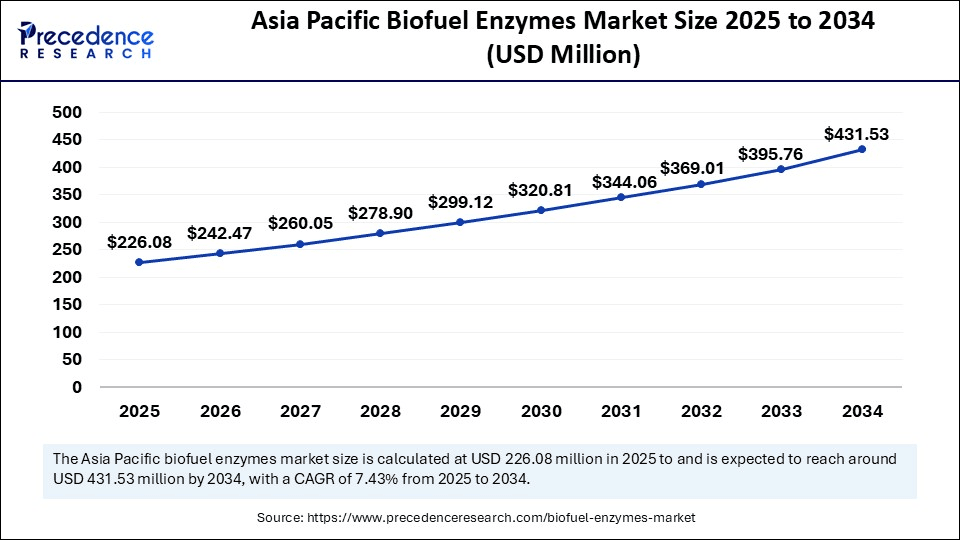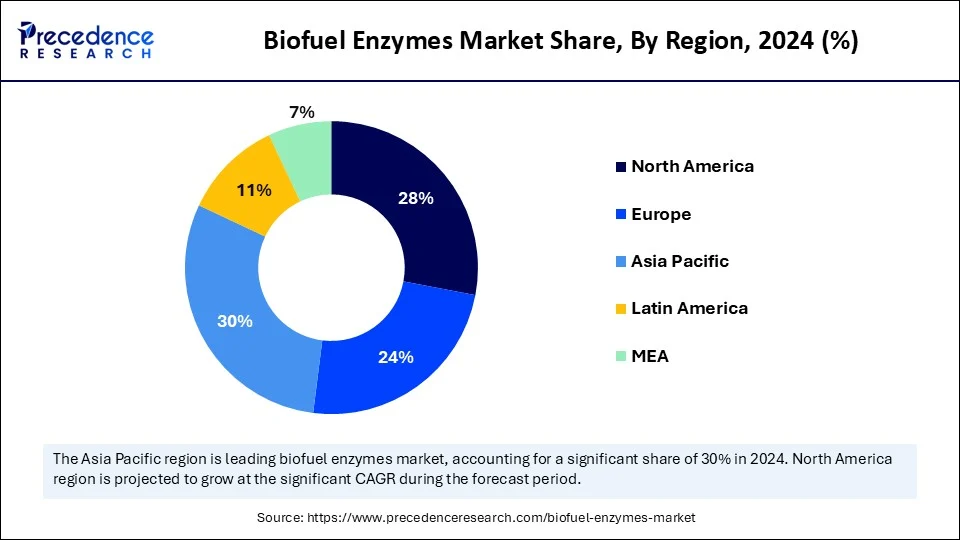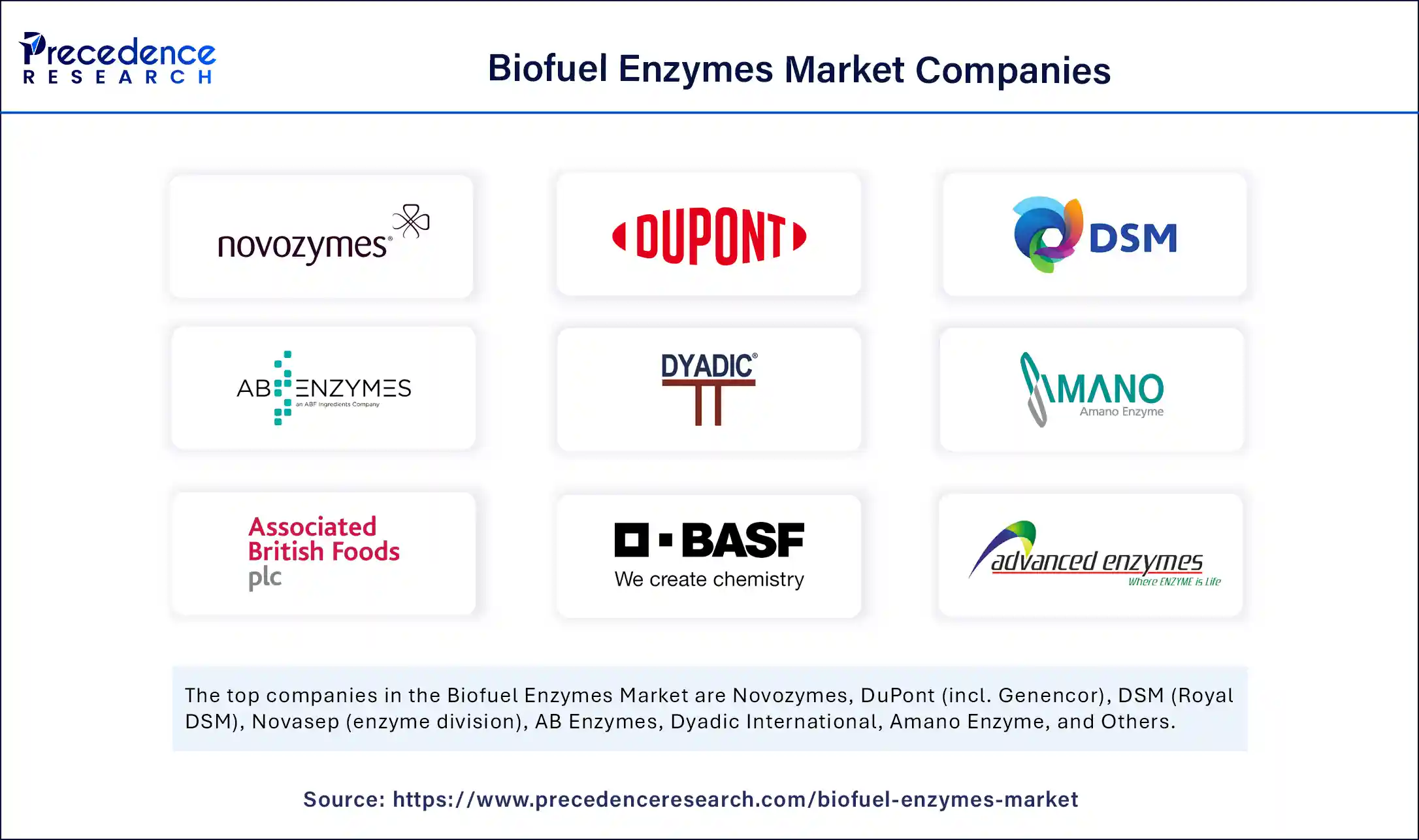List of Contents
What is the Biofuel Enzymes Market Size?
The global biofuel enzymes market size is accounted at USD 753.59 million in 2025 and predicted to increase from USD 808.23 million in 2026 to approximately USD 1,414.85 million by 2034, expanding at a CAGR of 7.25% from 2025 to 2034. The growing environmental concerns, increasing global energy demands, growing demand for biofuels, and the increasing popularity of sustainable and environmentally friendly alternatives are expected to propel the growth of the global biofuel enzymes market over the forecast period. Additionally, the market is rapidly expanding in various developing and developed regions, particularly the Asia Pacific, fuelled by a supportive regulatory environment, increasing adoption of renewable energy sources, and increasing focus on reducing reliance on fossil fuels.

Biofuel EnzymesMarket Key Takeaways
- In terms of revenue, the global biofuel enzymes market was valued at USD 702.65 million in 2024.
- It is projected to reach USD 1,414.85 million by 2034.
- The market is expected to grow at a CAGR of 7.25% from 2025 to 2034.
- Asia Pacific dominated the biofuel enzymes with the largest share of 30% in 2024.
- Middle East & Africa is anticipated to grow at the fastest CAGR during the forecast period.
- By enzyme type, the cellulases segment captured the biggest market share of 35% in 2024.
- By enzyme type, the lipases segment is expected to witness a significant share during the forecast period.
- By biofuel type, the bioethanol segment held the largest market share of 50% in 2024.
- By biofuel type, the biobutanol segment accounted for considerable growth over the forecast period.
- By application stage, the pretreatment/hydrolysis stage segment contributed the highest market share of 30% in 2024.
- By application stage, the waste-processing / residue treatment stage segment is expected to grow significantly during the forecast period.
- By form, the liquid enzyme formulation segment accounted for the significant market share of 45% in 2024.
- By form, the immobilized enzyme formulation segment is expected to witness remarkable growth during the forecast period.
- By end-user industry, the bioethanol producers segment generated the major market share of 50% in 2024.
- By end-user industry, the small/decentralized biofuel units segment is projected to grow at a CAGR between 2025 and 2034.
How Can Artificial Intelligence Improve the Biofuel Enzymes Market?
In today's rapidly evolving technological landscape, Artificial intelligence emerges as a game-changer and holds potential for growth and innovation in the biofuel enzymes market. Machine learning (ML) algorithms allow for rapid screening of enzyme variants, minimize R&D timelines, and improve precision in selecting enzymes. AI algorithms assist in predicting optimal mutations for enhancing enzyme function, which allows prominent researchers to effectively engineer enzymes with increased catalytic efficiency and stability. The incorporation of AI in the biofuel enzymes market offers a promising pathway to address issues associated with traditional biofuel production methods, which leads to more sustainable, efficient, and economically viable biofuel technologies. AI's role in accelerating the research process positions it as a crucial tool responsible for advancing the global transition towards a more sustainable future.
Why Are Biofuel Enzymes Crucial for Sustainable Energy?
The biofuel enzymes market focuses on utilizing enzymes, specifically in biofuel production processes (e.g., cellulose-degrading cellulases, hemicellulases, ligninases, lipases, etc.) to convert biomass (such as cellulosic feedstocks, starches, vegetable oils) into biofuels (like bioethanol, biodiesel, bio-butanol). These enzymes play a crucial role in breaking down complex organic materials, which facilitates the conversion of biomass into biofuels. These industrial enzymes improve yield, process efficiency, cost-effectiveness, and environmental sustainability of biofuel production.
What Are the Latest Trends in the Biofuel Enzymes Market?
- The increasing consumption of biodiesel and bio-based ethanol across various end-use industries such as automotive, aviation, construction, agriculture, pharmaceuticals, chemical manufacturing, power generation, and others, is driving the market expansion during the forecast period.
- The increasing environmental concerns along with the rising global shift from diesel to biodiesel are anticipated to accelerate the market's revenue during the forecast period.
- The growing adoption of advanced enzyme technologies, which hold potential to improve the efficiency and yield of biofuel production, is bolstering the growth of the market during the forecast period.
- The growing demand for bio-based ethanol and rising awareness in regards to the environmental benefits significantly boost the market during the forecast period.
- The surging global energy demands and favourable government incentives for cleaner fuel alternatives are expected to propel the expansion of the biofuel enzymes market in the coming years.
- The rapid innovations in biotechnology and genetic engineering are anticipated to contribute to the overall growth of the biofuel enzymes market. Such factors have led to the development of more efficient and effective enzymes for the production of biofuel.
Market Outlook
- Industry Growth Offerings- The biofuel enzymes industry is growing due to expanded use of sustainable feedstocks, advanced enzyme engineering, and cost-saving techniques like immobilization. Rising demand for second-generation biofuels and eco-friendly production methods further boosts market growth.
- Global expansion- The biofuel enzymes industry is growing due to expanded use of sustainable feedstocks, advanced enzyme engineering, and cost-saving techniques like immobilization. Rising demand for second-generation biofuels and eco-friendly production methods further boosts market growth.
- Startup Ecosystem- The startup ecosystem for biofuel enzymes is growing, with emerging firms focusing on advanced biocatalysts, enzyme engineering, and biomass conversion technologies. These startups collaborate with research institutes, biorefineries, and energy companies to commercialize innovative and sustainable biofuel solutions.
Market Scope
| Report Coverage | Details |
| Market Size by 2034 | USD 1,414.85 Million |
| Market Size in 2025 | USD 753.59 Million |
| Market Size in 2026 | USD 808.23 Million |
| Market Growth Rate from 2025 to 2034 | CAGR of 7.25% |
| Dominating Region | North America |
| Fastest Growing Region | Asia Pacific |
| Base Year | 2024 |
| Forecast Period | 2025 to 2034 |
| Segments Covered | Enzyme Type, Biofuel Type, Application Stage, Form, End-user Industry, and Region |
| Regions Covered | North America, Europe, Asia-Pacific, Latin America, and Middle East & Africa |
Market Dynamics
Drivers
How Is the Rising Demand for Biofuel and Technological Advancement Impacting the Market's Growth?
The increasing demand for biofuel and technological advancement are expected to boost the growth of the biofuel enzymes market during the forecast period. Biofuels are gaining immense popularity as a viable substitute for traditional fossil fuels, contributing to nearly 40% to 60% lower emissions compared to conventional fossil fuels. The rising concerns about climate change and the increasing need to reduce greenhouse gas (GHG) emissions have led to a rising demand for biofuels as a cleaner alternative to fossil-based fuels. The market is experiencing a global trend towards sustainable energy solutions, which accelerates the increasing adoption of biofuel enzymes across various industries. Moreover, technological advancements in enzyme technology are significantly contributing to the development of more efficient and specialized enzymes for various feedstocks. Additionally, advancements in enzyme technology, such as the development of more efficient and specialized enzymes for various feedstocks, are expected to drive market expansion. Advanced techniques such as genetic engineering and fermentation optimization are significantly reducing production costs and improving enzyme performance.
Restraint
High Initial Costs
The high cost is anticipated to hamper the market's growth. A huge upfront capital investment is required for the production costs of biofuel enzymes, which can be a barrier to limited financial resources. In addition, the competition from fossil fuels and the rising adoption of electric vehicles are likely to limit the expansion of the global biofuel enzymes market.
Opportunity
Supportive Government Policies
The supportive government policies and increasing focus on sustainability are projected to offer lucrative growth opportunities to the biofuel enzymes market during the forecast period. Several governments around the world are implementing regulations and incentives to promote the use of biofuels, which encourages enzyme manufacturers to develop more efficient and sustainable solutions. Supportive government policies, including tax credits, subsidies, and grants, promote the use of biofuel production to reduce greenhouse gas emissions and lower dependence on fossil fuels. The regulatory push has led to an increasing investment in renewable energy sources like biofuel. Therefore, governments of various countries are actively supporting and offering strong policy support for renewable energy initiatives, bolstering the market's growth during the forecast period.
- In August 2025, Bihar launched its newly amended Biofuel Policy 2025, marking a major step toward sustainable industrial growth and positioning the state as a future green energy hub. The policy aims to attract substantial investment in the biofuel sector, create large-scale employment, and provide significant environmental benefits. Deputy Chief Minister announced an ambitious target of establishing 10 Compressed Biogas (CBG) plants in Bihar by the end of this year, with an expected investment of over Rs1,500 crore. These plants are projected to produce 5 lakh tonnes of CBG annually.
(Source: https://patnapress.com)
Enzyme Type Insights
Which Segment Is Dominating the Market by Technology Type in the Biofuel Enzymes Market?
The cellulases segment dominated the global biofuel enzymes market in 2024. Cellulases break down cellulose into usable sugars and play a critical role, particularly for second-generation biofuel production. It offers excellent efficiency in converting lignocellulosic feedstocks, such as agricultural residues and non-food crops, making it the most preferred choice among biofuel producers. The are mainly three types of cellulase enzymes, which include Endoglucanases (EG), Cellobiohydrolases (CBH), and β-Glucosidases (BG). The rising demand for sustainable biofuel solutions globally enhances the importance of cellulase in improving biomass utilization, propelling the segment's expansion during the forecast period.
On the other hand, the lipases are expected to witness remarkable growth during the forecast period. Lipases are gaining significant popularity in biodiesel production owing to their high efficiency in the transesterification process, which converts triglycerides (vegetable oils and animal fats) into biodiesel. Lipases enable efficient high-yield biodiesel production from animal fats, vegetable oils, and waste cooking oils, providing a greener alternative to chemical catalysts.
Application Stage Insights
Which Segment Is Dominating the Market by Application Stage in the Biofuel Enzymes Market?
The pretreatment/hydrolysis stage segment dominated the global biofuel enzymes market in 2024. The high effectiveness of enzymatic hydrolysis mainly relies on the pretreatment process. In biofuel production, the pretreatment and enzymatic hydrolysis stages play an essential role in converting lignocellulosic biomass into usable sugars for fermentation. Pretreatment enhances enzyme accessibility by efficiently breaking down its complex structure of biomass. Enzymatic hydrolysis then utilizes enzymes to convert cellulose into fermentable sugars.
On the other hand, the waste-processing / residue treatment stage segment is expected to witness remarkable growth during the forecast period. The waste-processing/residue treatment stage of biofuel production is a crucial area, contributing to improved efficiency and yield. The waste-processing stage in biofuel production generally involves pretreating several feedstocks, such as municipal solid waste, agricultural residues, and algae. Residue treatment efficiently manages and handles the byproducts and waste generated during biofuel production.
Form Insights
What Causes the Liquid Enzyme Formulation to Dominate the Biofuel Enzymes Market?
The liquid enzyme formulation held a dominant presence in the biofuel enzymes market in 2024. Liquid enzyme formulations are most widely utilised in biofuel production to catalyze reactions that convert biomass into fuel. Liquid enzymes are the most preferred formulation market and offer benefits such as ease of application, compatibility with continuous processing, and improved performance. Liquid enzymes are easily integrated into existing biofuel production systems and react swiftly, which results in efficient biomass conversion.
On the other hand, the immobilized enzyme formulation segment is expected to grow at a notable rate. Immobilized enzymes are considered stable and resistant to various changes in pH, temperature, and other environmental factors. Enzyme immobilization allows for large-scale biofuel production, enhancing enzyme stability and reusability for processes such as biodiesel and ethanol production. There are several benefits of immobilized enzymes in biofuel production, which include improved stability, increased reusability, and enhanced separation.
Biofuel Type Insights
How Will the Bioethanol Segment Dominate the Market in 2024?
The bioethanol segment held the majority of the market share in 2024. Bioethanol is a type of biofuel and is primarily produced through the fermentation of sugars derived from various sources, such as corn, wheat, algae, sugarcane, and various other starch-rich crops. Bioethanol is widely used as an additive to fuels to reduce climate change emissions and offers a promising pathway to lower reliance on fossil fuels. On the other hand, the biobutanol segment is projected to grow at a CAGR between 2025 and 2034. The growth of the segment is driven by the growing demand for biobutanol as a sustainable and renewable biofuel. Biobutanol production is a promising biofuel alternative, can be produced by optimizing the enzymatic hydrolysis of biomass. Biobutanol is a high-energy biofuel, making it an excellent alternative to fossil fuels. Several researchers are increasingly focusing on exploring new feedstocks, improving microbial strains through genetic engineering and adaptive evolution, and increasing their investment to develop innovative fermentation and recovery technologies.
End-user Industry Insights
How Did Bioethanol Producers Dominate the Biofuel Enzymes Market in 2024?
The bioethanol producers segment held the largest share in the biofuel enzymes market in 2024, owing to the rising global demand for bioethanol production as a sustainable alternative. Several prominent market players in the market include Novozymes, DuPont, DSM, AB Enzymes, Codexis Inc., and others. Increasingly focusing on developing advanced enzyme technologies to improve the efficiency and cost-effectiveness of biofuel production. The majority of the bioethanol producers are from Brazil, the United States, and India, which are also key consumers of these enzymes.
On the other hand, the small/decentralized biofuel units segment is expected to grow significantly in the coming years. Small and decentralized biofuel units play a significant role in the biofuel enzymes market by offering an available source of biomass and enabling localized production. These units widely utilize food waste, agricultural residues, and various other organic materials, creating a strong distributed network for biofuel production. This localized approach often results in lowering transportation costs and reliance on large-scale centralized facilities, making biofuel production more accessible, especially in remote or rural areas. Additionally, supportive government policies and regulatory frameworks encourage the development and deployment of small-scale biofuel production.
Regional Insights
Asia Pacific Biofuel Enzymes Market Size and Growth 2025 to 2034
The Asia Pacific biofuel enzymes market size is exhibited at USD 226.08 million in 2025 and is projected to be worth around USD 431.53 million by 2034, growing at a CAGR of 7.43% from 2025 to 2034.

Asia Pacific Is Dominating the Market With the Majority of the Market Share
Asia Pacific held the dominant share of the biofuel enzymes market in 2024. The region's extensive agricultural resources provide wide accessibility and cost-effective feedstock for biofuel production. Asia-Pacific countries such as India, Japan, Singapore, and China are increasingly seeking innovative ways to reduce their reliance on fossil fuels and enhance their energy security, which drives the expansion of the biofuel enzymes market. The growing environmental concerns about climate change and the rising focus need to reducing carbon footprint have led to a shift towards renewable energy sources, driving the demand for biofuels. The region's commitment to reducing carbon emissions is likely to fuel the adoption of bio-fuel across various sectors transportation, construction, agriculture, pharmaceuticals, chemical manufacturing, power generation, and others, which is driving the market expansion during the forecast period in the region. The market for biofuel enzymes is propelled by ongoing technological advancements in biotechnology and enzymology aimed at facilitating the production of enzymes that can accelerate biomass conversion to biofuel. Additionally, government initiatives and policies are likely to promote the development of biofuels and drive innovation in enzyme production technology.
Biofuel Enzymes Market Trends in India
The country accounted for the majority of market revenue share in 2024, fuelled by growing demand for biofuels, supportive government policies, and rising environmental concerns. Moreover, the increasing concerns about climate-damaging and the expansion of renewable energy infrastructure are anticipated to propel the market's expansion in the coming years.
Biofuels represent a cleaner energy source that is derived from organic sources such as biomass and organic waste. India has achieved 19.6% ethanol blending in petrol as of January 2025 and is on track to reach 20%, five years ahead of its original 2030 target. Several Indian government efforts are responsible for biofuel expansion, which include Pradhan Mantri JI-VAN Yojana (Jaiv Indhan – Vatavaran Anukool fasal awashesh Nivaran Yojana), GOBAR-Dhan Scheme (Galvanizing Organic Bio-Agro Resources Dhan), and SATAT Scheme (Sustainable Alternative Towards Affordable Transportation).(Source: https://www.nextias.com)

The Middle East & Africa Are Expected to Grow at the Fastest Rate in the Market
The Middle East & Africa are expected to grow at the fastest rate in the market during the forecast period. The fastest growth of the region is mainly fuelled by the growing demand for biofuel in various industries, government incentives promoting sustainable energy, increasing renewable energy investments, and advancements in enzyme technology. Biofuels are increasingly being promoted as a low-carbon alternative to fossil fuels, as they assist in reducing greenhouse gas (GHG) emissions and the related climate change. The market is experiencing increased investment in research for the development of enzyme technologies that can make biofuel production more efficient. The region's favorable regulatory frameworks encourage the adoption of biofuel, including government subsidies and tax credits for clean energy.
Why Enzymatic Biofuel Production is Expanding Rapidly in Egypt?
Egypt's market is growing due to increasing bioethanol production driven by abundant agricultural residues and crop by-products suitable for biomass conversion. Government initiatives promoting renewable energy and sustainability are encouraging the adoption of enzymatic processes. Rising investments in fermentation-based biofuel plants, coupled with the focus on improving yield, process efficiency, and cost-effectiveness, are further fueling market expansion across the country.
What Driving Surge in Europe's Biofuel Industry?
Europe's biofuel market is growing due to stringent government mandates under the EU's Renewable Energy Directive, driving high demand for biodiesel and bioethanol. Innovation in advanced biofuels made from waste and non-food biomass boosts sustainability. Rising mandates for sustainable aviation fuel (SAF) also accelerate biofuel consumption.
What Factors Are Fueling the Rise of Biofuels in the UK?
The UK market is expanding due to government initiatives promoting Sustainable Aviation Fuel (SAF) and low-carbon fuels, including a 10% SAF mandate by 2030. Strong funding schemes and revenue certainty encourage investments in bioethanol and biodiesel production. Rising demand for renewable energy, coupled with policies supporting domestic biofuel manufacturing and decarbonization goals, is driving the growth of advanced and sustainable biofuel solutions across the country.
Biofuel Enzymes Market – Value Chain Analysis
- Resource Extraction: The production of biofuels primarily relies on enzyme-based processes, where enzymes facilitate the conversion of complex biomass into simpler compounds, playing a critical role in biodiesel, bioethanol, and other renewable fuel production.Biofuel enzymes, such as cellulases, lipases, proteases, hemicellulases, and amylases, act as catalysts, breaking down complex organic materials into simpler molecules that can be fermented into sugar or further processed into biofuels like biodiesel and ethanol.
- Power Generation: Biofuel enzymes are critical for power generation and are considered an excellent renewable energy source to reduce greenhouse gas emissions. There are several ways to generate power from biomass and biofuels, such as combustion, gasification, anaerobic digestion, and liquid fuel conversion. There are different types of biofuels used in power generation, including bioethanol, biodiesel, biogas/biomethane, and biomass.
- Energy Storage Systems: Biofuels can be stored in tanks or utilized in specialized systems like bioenergy with carbon capture and storage (BECCS). Stored biofuels can be used to generate electricity in power plants, power vehicles, and provide heat for industrial processes. Biofuel storage systems can be integrated with other renewable energy sources, such as wind and solar, to create hybrid energy systems.
Value Chain Analysis
Feedstock Procurement
- Feedstock procurement focuses on sourcing sustainable biomass such as agricultural residues, crop waste, and non-food plant materials.
- Biofuel enzymes like cellulases and hemicellulases break down complex biomass into fermentable sugars for biofuel production.
- Efficient procurement ensures cost-effective, high-yield enzyme-based conversion, critical for advanced (second-generation) biofuels.
Key players: Novozymes, DuPont Industrial Biosciences, DSM, and AB Enzymes.
Chemical Synthesis and Processing
- Enzymatic biofuel production offers a sustainable alternative to traditional chemical methods, using specific enzymes to convert biomass into usable fuels.
- Key processes include enzyme engineering to develop more efficient and resilient biocatalysts.
- Advanced techniques like enzyme immobilization enhance stability and reduce production costs.
Key players: DSM, DuPont Industrial Biosciences, and AB Enzymes.
Waste Management and Recycling
- Waste management in biofuel enzyme production focuses on recycling organic materials, such as agricultural residues and food waste, using biorefineries.
- Enzymes from microorganisms break down complex waste into fermentable sugars for biofuel production.
- Processes can integrate technologies like anaerobic digestion to generate biogas alongside liquid biofuels.
Key players: Novozymes, DSM, DuPont Industrial Biosciences, and AB Enzymes.
Top Vendors and their Offerings
- AB Enzymes: Develops industrial enzymes for biofuel, food, and feed applications, focusing on cellulases, hemicellulases, and other biocatalysts to improve biomass conversion and production efficiency.
- Co-Exist: Provides sustainable enzyme solutions for biofuels and biorefineries, specializing in advanced biocatalysts that enhance the breakdown of lignocellulosic and starch-based feedstocks.
- Prozomix: Offers recombinant enzymes and microbial systems for industrial applications, including biofuel production, emphasizing high-yield and cost-effective biomass conversion technologies.
- Amano Enzymes: Supplies a wide range of enzymes for industrial uses, including cellulases, amylases, and lipases, supporting biofuel production and other biotechnological processes.
- DSM: Delivers industrial enzymes and biocatalysts for biofuels, feed, and food industries, enhancing efficiency, sustainability, and yield in biomass-to-biofuel conversion processes.
Biofuel Enzymes Market Companies

- Novozymes
- DuPont (incl. Genencor)
- DSM (Royal DSM)
- Novasep (enzyme division)
- AB Enzymes
- Dyadic International
- Amano Enzyme
- Enzyme Bio-Works
- Associated British Foods (ABF) – PPL Enzyme
- BASF (enzymes for industrial use)
- Royal Enzymes
- Advanced Enzyme Technologies Ltd.
- Kerry Group (enzymes business)
- Codexis
- Bio-Catalysts Ltd.
- Chr. Hansen (enzyme portfolio)
- Prozomix
- BBI Enzymes (part of BBI Solutions)
- Enzyme Innovation Pvt. Ltd.
- Summit Enzymes GmbH
Recent Developments
- In June 2024, BASF sold its bioenergy enzymes business based in San Diego to Lallemand's subsidiaries, Danstar Ferment AG and Lallemand Specialties Inc. This includes the Spartec product portfolio and related technologies in development. Lallemand will integrate the business and associated employees in its Lallemand Biofuels & Distilled Spirits (LBDS) business unit.(Source: https://www.basf.com)
- In April 2025, eXoZymes Inc., a pioneer of AI-engineered enzymes that can transform sustainable feedstock into nutraceuticals, medicines, and other essential chemicals, announced its latest initiative - BioClick - a pioneering concept designed to enhance and accelerate the engineering of enzymes for advanced chemical reactions. Funded in part by a $300K grant from the National Institutes of Health (NIH), this project has the potential to revolutionize how medicines and other bio-based compounds are created.(Source: https://www.globenewswire.com)
Segmentation Covered in the Report
By Enzyme Type
- Cellulases
- Hemicellulases
- Ligninases
- Lipases
- Amylases
- Others (e.g., proteases, esterases specific for biofuel pathways)
By Biofuel Type
- Bioethanol
- Biodiesel
- Biobutanol
- Other Biofuels (e.g., bio-jet fuel, bio-methanol, biomethane intermediates)
By Application Stage
- Pretreatment / Hydrolysis Stage
- Esterification / Transesterification Stage
- Fermentation / Conversion Stage
- Blending / Purification Stage
- Waste-processing / Residue Treatment Stage
By Form
- Liquid Enzyme Formulation
- Powder / Solid Enzyme Formulation
- Immobilized Enzyme Formulation
By End-user Industry
- Bioethanol Producers (Large-scale)
- Biodiesel Producers (Large-scale)
- Small / Decentralized Biofuel Units
- OEMs / Fuel Additive Suppliers
- Research & Academic Institutions
By Region
- North America
- Europe
- Asia Pacific
- Latin America
- Middle East and Africa
For inquiries regarding discounts, bulk purchases, or customization requests, please contact us at sales@precedenceresearch.com
Frequently Asked Questions
Ask For Sample
No cookie-cutter, only authentic analysis – take the 1st step to become a Precedence Research client